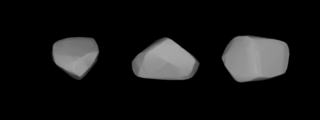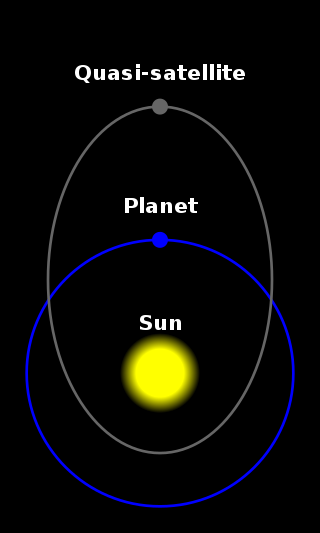Related Research Articles

3753 Cruithne is a Q-type, Aten asteroid in orbit around the Sun in 1:1 orbital resonance with Earth, making it a co-orbital object. It is an asteroid that, relative to Earth, orbits the Sun in a bean-shaped orbit that effectively describes a horseshoe, and that can change into a quasi-satellite orbit. Cruithne does not orbit Earth and at times it is on the other side of the Sun, placing Cruithne well outside of Earth's Hill sphere. Its orbit takes it near the orbit of Mercury and outside the orbit of Mars. Cruithne orbits the Sun in about one Earth year, but it takes 770 years for the series to complete a horseshoe-shaped movement around Earth.

Achilles is a large Jupiter trojan asteroid of the Greek camp. Achilles was the first Jupiter trojan to be discovered, and was discovered by Max Wolf at the Heidelberg Observatory in 1906. Wolf named the minor planet after the legendary hero Achilles from Greek mythology. The dark D-type asteroid measures approximately 133 kilometers in diameter which makes it one of the 10 largest Jupiter trojans. It has a rotation period of 7.3 hours and possibly a spherical shape.

1862 Apollo is a stony asteroid, approximately 1.5 kilometers in diameter, classified as a near-Earth object (NEO). It was discovered by German astronomer Karl Reinmuth at Heidelberg Observatory on 24 April 1932, but lost and not recovered until 1973.

2002 AA29 (also written 2002 AA29) is a small near-Earth asteroid that was discovered on January 9, 2002 by the LINEAR (Lincoln Near Earth Asteroid Research) automatic sky survey. The diameter of the asteroid is only about 20–100 metres (70–300 ft). It revolves about the Sun on an almost circular orbit very similar to that of the Earth. This lies for the most part inside the Earth's orbit, which it crosses near the asteroid's furthest point from the Sun, the aphelion. Because of this orbit, the asteroid is classified as Aten type, named after the asteroid 2062 Aten.
2003 YN107 is a tiny asteroid, classified as a near-Earth object of the Aten group moving in a 1:1 mean-motion resonance with Earth. Because of that, it is in a co-orbital configuration relative to Earth.

A quasi-satellite is an object in a specific type of co-orbital configuration with a planet where the object stays close to that planet over many orbital periods.

5261 Eureka is the first Mars trojan discovered. It was discovered by David H. Levy and Henry Holt at Palomar Observatory on 20 June 1990. It trails Mars (at the L5 point) at a distance varying by only 0.3 AU during each revolution (with a secular trend superimposed, changing the distance from 1.5–1.8 AU around 1850 to 1.3–1.6 AU around 2400). Minimum distances from Earth, Venus, and Jupiter, are 0.5, 0.8, and 3.5 AU, respectively.
760 Massinga is a large background asteroid from the outer regions of the asteroid belt, approximately 70 kilometers in diameter. It was discovered by German astronomer Franz Kaiser at the Heidelberg Observatory on 28 August 1913. The stony S-type asteroid has a rotation period of 10.7 hours and is somewhat elongated in shape. It was named in memory of Adam Massinger (1888–1914), a German astronomer at Heidelberg who was killed in World War I.

807 Ceraskia is an elongated Eos asteroid from the outer regions of the asteroid belt. It was discovered on 18 April 1915, by German astronomer Max Wolf at the Heidelberg-Königstuhl State Observatory in southwest Germany. The S-type asteroid has a rotation period of 7.4 hours and measures approximately 24 kilometers in diameter. It was named after Belarusian–Soviet astronomer Vitold Cerasky (1849–1925).

524522 Zoozve (provisional designation 2002 VE68) is a sub-kilometer sized asteroid and temporary quasi-satellite of Venus. Discovered in 2002, it was the first such object to be discovered around a major planet in the Solar System. In a frame of reference rotating with Venus, it appears to travel around it during one Venerean year, but it orbits the Sun, not Venus.
1425 Tuorla, provisional designation 1937 GB, is a stony Eunomian asteroid from the central regions of the asteroid belt, approximately 14 kilometers in diameter. It was discovered on 3 April 1937, by Finnish astronomer Kustaa Inkeri at the Iso-Heikkilä Observatory in Turku, southwestern Finland. The asteroid was named after the Tuorla Observatory of the University of Turku. It was Kustaa Inkeri's only asteroid discovery.
(277810) 2006 FV35, provisional designation 2006 FV35, is a sub-kilometer near-Earth asteroid in the dynamical Apollo asteroid group, discovered by Spacewatch at Kitt Peak National Observatory, Arizona, on 29 March 2006. It is a quasi-satellite of Earth. It is also notable for having a low delta-v requirement for rendezvous. Although its orbital period is almost exactly 1 year, the orbit of 2006 FV35 has a high eccentricity which causes it to cross the paths of both Venus and Mars.
Paul Arnold Wiegert is a Canadian astronomer, discoverer of minor planets and professor at the University of Western Ontario.
2014 OL339 (also written 2014 OL339) is an Aten asteroid that is a temporary quasi-satellite of Earth, the fourth known Earth quasi-satellite.
2013 LX28, is an asteroid, classified as near-Earth object of the Apollo group that is a temporary quasi-satellite of the Earth, the third known Earth quasi-satellite.
2015 SO2 (also written 2015 SO2) is an Aten asteroid that is a temporary horseshoe companion to the Earth, the ninth known Earth horseshoe librator. Prior to its most recent close encounter with our planet (2015 September 30) it was an Apollo asteroid.

469219 Kamoʻoalewa, provisionally designated 2016 HO3, is a very small asteroid, fast rotator and near-Earth object of the Apollo group, approximately 40–100 meters (130–330 feet) in diameter. At present it is a quasi-satellite of Earth, and currently the second-smallest, closest, and most stable known such quasi-satellite (after 2023 FW13). The asteroid was discovered by Pan-STARRS at Haleakala Observatory on 27 April 2016. It was named Kamoʻoalewa, a Hawaiian word that refers to an oscillating celestial object. The Earth-like orbit and lunar-like silicates may be a result of it being lunar ejecta.

(164121) 2003 YT1, provisional designation 2003 YT1, is a bright asteroid and synchronous binary system on a highly eccentric orbit, classified as near-Earth object and potentially hazardous asteroid of the Apollo group, approximately 2 kilometers (1.2 miles) in diameter. It was discovered on 18 December 2003, by astronomers with the Catalina Sky Survey at the Catalina Station near Tucson, Arizona, in the United States. The V-type asteroid has a short rotation period of 2.3 hours. Its 210-meter sized minor-planet moon was discovered at Arecibo Observatory in May 2004.

594913 ꞌAylóꞌchaxnim (provisional designation 2020 AV2) is a large near-Earth asteroid discovered by the Zwicky Transient Facility on 4 January 2020. It is the first asteroid discovered to have an orbit completely within Venus's orbit, and is thus the first and only known member of the eponymous ꞌAylóꞌchaxnim (informally named Vatira before its discovery) population of Atira-class asteroids. ꞌAylóꞌchaxnim has the smallest known aphelion and third-smallest known semi-major axis among all asteroids. With an absolute magnitude approximately 16.2, the asteroid is expected to be larger than 1 km in diameter.
2020 PP1 is a sub-kilometer asteroid, classified as a near-Earth object of the Apollo group, that is a temporary quasi-satellite of the Earth. There are over a dozen known Earth quasi-satellites, some of which switch periodically between the quasi-satellite and horseshoe co-orbital states.
References
- ↑ Mikkola, Seppo (2008). "Regular Algorithms for the Few-Body Problem". The Cambridge N-Body Lectures. Lecture Notes in Physics. Vol. 760. pp. 31–58. Bibcode:2008LNP...760...31M. doi:10.1007/978-1-4020-8431-7_2. ISBN 978-1-4020-8430-0.
- ↑ "Discovery of the first quasi-satellite of Venus". Tuorla Observatory . 17 August 2004. Retrieved 29 January 2024.
- ↑ Mikkola, S.; Brasser, R.; Wiegert, P.; Innanen, K. (2004). "Asteroid 2002 VE68, a quasi-satellite of Venus". Monthly Notices of the Royal Astronomical Society. 351 (3): L63–L65. Bibcode:2004MNRAS.351L..63M. doi:10.1111/j.1365-2966.2004.07994.x.